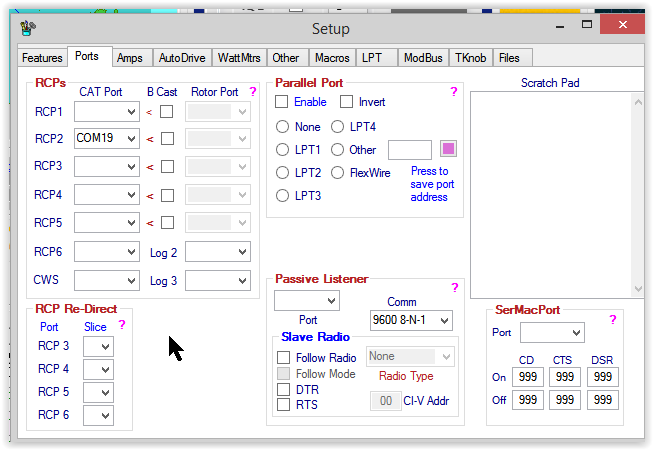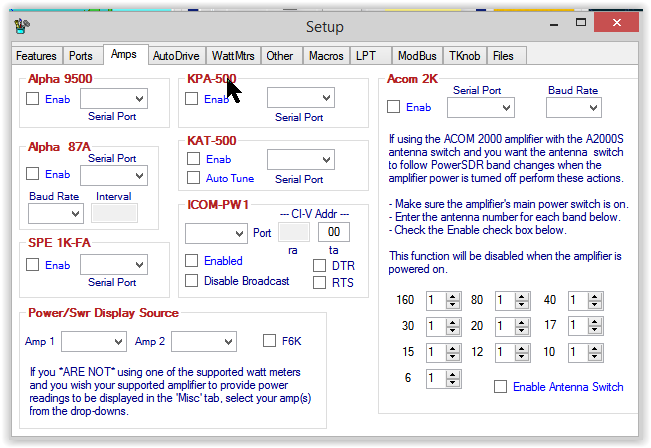The integration is as follows:
If you click the above pic all the way to the left are 2 skimmerfalls, one on 40 and one on 20. Stations decoded by skimmer, that is stations I am actually receiving at my station are transferred to the WriteLog bandmaps. If I had 4 waterfalls as in the 6500 I could decode 4 bands at once. I also am decoding spots provided by ve7cc (the program in the lower right) and those spots are also added to the proper bandmap.
From this box I pretty much run the contest. If I click on a callsign in the bandmap it is entered into the logbox. I can then make the contact tab to the fields and enter the data, press enter and the contact is logged. If I am running I enter the data by keyboard, and that station if not already there is added to the bandmap and his callsign is turned dark blue. Any station I work is turned dark blue so I can keep track visually
The fact that I can populate bandmap with local signals is very powerful
I also use DDUTIL to control my FlexControl, AKA the Knob. It makes for rapid ability to tune either VFO. TX focus follows which "radio" is active. In other words if the 20M window is active the transmitter goes with that window. If the 40M window is active the transmitter goes with that window. Window focus switches using the up/down cursor keys on the keyboard or by clicking the radio the bandmap or skimmer.
I also control my radio using the Genovation keypad
Both of these are always available in that I can be in any window and press a button or turn the knob and the radio will respond. The keypad allows up to 47 key combinations which will fire macros contained in DDUTIL. I can immediately change the screen width for example with a single button press.
One press centers the VFO in the panadapter and sets the pan to 19khz bandwidth.
One press takes me to a 60khz wide shot, and one press takes me back to 19khz. You can do many things at once. I have a CWDX macro which locks VFOA on the DX, mutes VFOB, sets the bandwidth to 50hz, and the TX to VFOB for immediate use in a pileup. There are literally hundreds of possibilities. One button turns off the TX line to my amp, turns on tune at 10W allowing me to tune my tuner which will fire a tuning cycle automatically. One more press of the same button undoes what the first press did, and I am ready to transmit a KW and I never worry about getting things out of sequence. This works with all 4 of my amps no matter which I choose.
This board allows me to pull BCD band data out of my radio which allows my smart amp and smart antenna switch to follow my radio's freq. So when I choose 20M the amp and antenna are on 20M ready to go. When I choose 40M every thing falls into place and I'm ready to transmit.
Included is a little primer video I made to show some of this in action
Best viewed in 720 or 1080.
The wires that connect all this are the I/Q and regular audio feeds from DAX
With the software described everything is connected to the radio in a independent client/server fashion. SDR-Bridge, DDUTIL and SSDR all have their own IP addresses and independently address the API of the radio. This is why things run soooo smoothly. There are no bottle necks and no crashes. I could also adde other programs through SmartCAT
You can see the CAT program also connects to the radio in a client/server fashion.
Here is a map of various ports I have presently configured. These are real ports, usb ports (like winkeyer, Genovation keypad and my 2 flex controls I use one on the 6300 and one on my Anan 100D) and 5 virtual pairs which work with any program like DXLab and Winwarbler,
There are other ways to deploy the station but this is the configuration I am using this month. Who knows what next month brings. It's a very powerful system, well beyond what you can do with legacy radios. This description does not address all of the subtlety of the programs and interconnections but gives a good flavor of what is possible. None of this is in stone. The program authors are very amenable to building a better mousetrap.
73 W9OY


















































